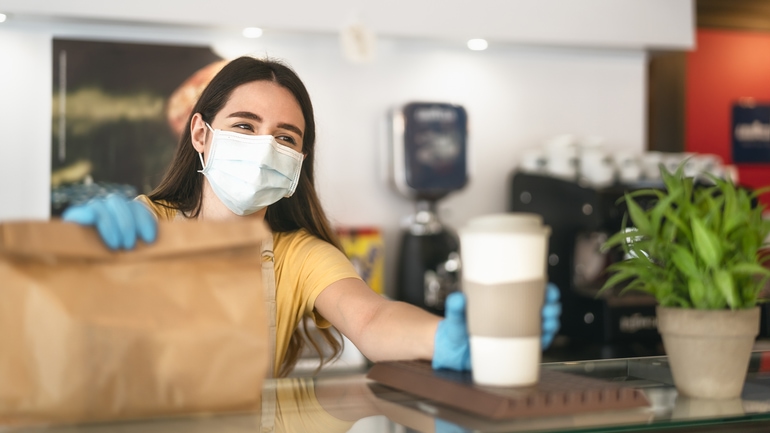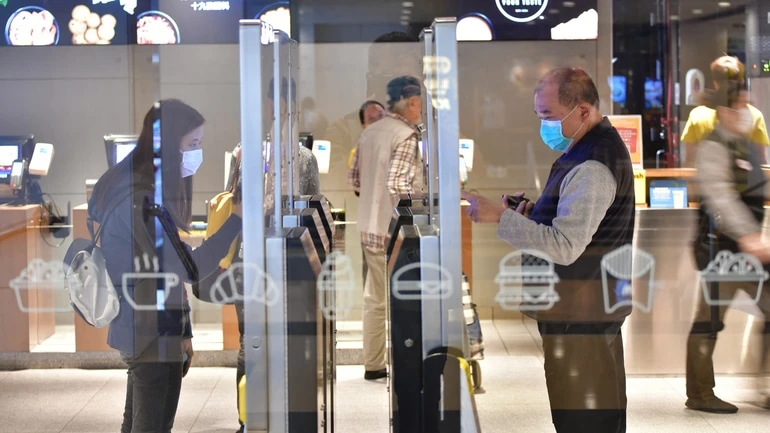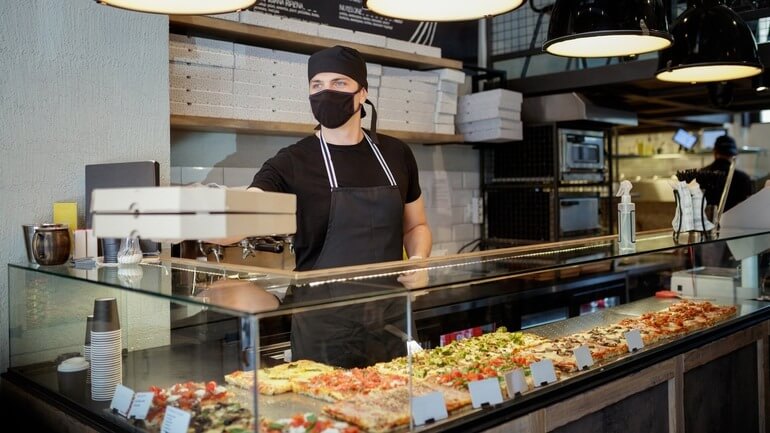From limited service restaurants to full service and everything in between, the options for venturing into restaurateurship are seemingly endless. It’s simply a matter of finding the best fit for your business goals.
On one end of the spectrum are limited service restaurants. These venues are able to offer diners tasty meals at unbeatable speeds and prices in exchange for self service.
On the other end of the spectrum are full service restaurants, which, as their name implies, wait on guests from the moment they enter the venue to the moment they leave.
While both types of restaurants have their pros and cons, limited service restaurants have proven to be more nimble and resilient in the face of COVID-19. During one week of July 2020, limited service restaurants saw only a 9% decline in sales relative to where they were during that week the previous year, while FSRs experienced a 30% decrease in sales during that time compared to the previous year.
If you’re considering opening your own limited service restaurant, or pivoting your current business towards a more casual restaurant concept, this guide will provide you with everything you need to know.
You’ll learn:
- What is a limited service restaurant?
- The differences between a limited service vs full service restaurant
- Typical characteristics of a limited service restaurant
- The customer experience at a casual concept
- The technology you’ll need for a limited service model
- The benefits and challenges of operating a limited service restaurant
Without further ado…
What Is a Limited Service Restaurant?
A limited service restaurant, or “LSR” for short, is a restaurant in which service is kept to a minimum, and a customer’s interactions with staff ends when the customer receives their food. The typical guest experience involves the guest ordering, paying for, and picking up their meal from a checkout counter.
Unlike at a full service restaurant (FSR), LSRs don’t offer table service while guests dine. Customers usually have to help themselves to cutlery, refill their own beverages, bus their own tables, and pack up their leftovers.
Most types of quick service restaurants (QSRs) fall under the umbrella of limited service, including fast casual and fast food restaurants, coffee shops, bakeries, cafes, and some pizzerias. Think Chipotle, Panera Bread, and Starbucks.
Limited Service vs Full Service Restaurants
While the lines between limited and full service restaurants have been blurred because of the COVID-19 pandemic, there are several traditional differences between limited service vs full service restaurants.
At full service restaurants, diners can make reservations or walk in unannounced, and then a host seats guests immediately if there is no wait. In contrast, limited service restaurants don’t accept reservations and guests seat themselves after they order.
Servers and bussers help guests throughout the entire FSR dining experience: placing orders, checking guest satisfaction, delivering food, refilling drinks, handling payments, and clearing tables. At an LSR restaurant, guests serve themselves. They place orders at a front counter and typically bring their food to their tables, refill their own drinks, and clear their tables.
It may be helpful to think of limited service venues more as “self service” restaurants, since they rely on the guests helping themselves throughout the meal. Whereas full service restaurants take care of guests throughout every part of the dining experience.

Typical Characteristics of a Limited Service Restaurant
To give you a better sense of what a limited service restaurant looks like, we’ve broken down the common characteristics of the model:
- Guests seat themselves: Customers aren’t assigned tables. Rather, they choose their own seats after placing their orders.
- Waiting in a queue to order: Guests typically have to wait in a line to place orders, instead of placing an order tableside through a server.
- Pay at the beginning: Guests pay for their meals upon placing their orders, instead of at the end of their meal.
- Order all food at once: Instead of adding to their order throughout the meal, guests at a limited service restaurant order their entire meal upfront.
- Self service: If LSR guests dine on-premise, they have to help themselves to cutlery, drink refills, and condiments.
- Emphasis on takeout: Many limited service restaurants are optimized for takeout and delivery, and therefore serve food in disposable to-go dishes.
- Guests clear their own tables: Guests bus their own tables at LSRs. At fast food restaurants that use disposable dishes and reusable trays, guests throw away their trash and place trays on top of a trash can. Venues that use reusable dishes typically have bussing stations and expect guests to sort silverware, cups, and dishes into different bins.
Restaurants that exhibit most of these qualities qualify as limited service.
The Limited Service Restaurant Customer Experience
So what does the customer experience look like at a limited-service restaurant? Here’s an overview:
- Ordering and payment: Guests typically place orders at a counter with a cashier. The cashier takes payment at this time.
- Seating: Diners seat themselves at whatever tables are available. However, limited service restaurants focused on takeout and delivery may offer no seating at all.
- Receiving the food: Guests usually pick up food at a counter when it’s ready. Most LSR restaurants call out a number or name associated with the order to let guests know their food is ready. Some use buzzers, while others actually bring food to the guest’s table.
- During the meal: Diners are typically responsible for refilling their own drinks, and securing their own cutlery and condiments. If guests want more food, they have to go back to the order counter.
- After the meal: If customers want to take home leftovers, they have to ask staff for takeout containers and pack the leftovers up themselves. They may also have to return dishes, silverware, and cups to a bussing station.
LSRs rely on customers to do most of the heavy lifting when it comes to service.

Technology Used in Limited Service Restaurants
Technology plays an important role in helping limited services restaurants run smoothly. Though some venues are more tech-savvy than others, this is the hardware and software typically found in an LSR restaurant:
- POS: A point of sale system (POS) is the core of the LSR tech stack. It lets restaurants execute critical functions like processing orders, keeping track of inventory, and generating sales reports.
- Payments processor: A POS-integrated payment processor lets diners pay with their payment method of choice and helps reduce double entry, which ultimately keeps queues moving.
- Self-ordering kiosk: This tool lets customers place and pay for orders without interacting with a cashier. Self-ordering kiosks reduce lines and contact, which may make diners feel more comfortable in the wake of the COVID-19 pandemic.
- Customer facing display: A CFD is an essential part of a seamless drive-thru ordering system. It also creates a great experience for walk-in customers because it allows them to visually confirm their order and eliminates the risk of errors.
- Online ordering platform: Diners can place and pay for pick up and delivery orders directly through a restaurant’s website with this software.
- Loyalty software: A loyalty solution is a marketing tool that rewards customers for their repeat business.
- Kitchen display system: A kitchen display system helps the front of house (FOH) and back of house (BOH) communicate, ultimately helping the kitchen fulfill orders faster.
- Digital menu board: This large, eye-catching display gives customers the information they need to make ordering decisions before they reach the front of the line. Digital menu boards also let restaurants update their offerings quickly and easily.
These QSR technology solutions make running an LSR restaurant easier and help to ensure a great guest experience.
Benefits of Running a Limited Service Restaurant
Operating a limited services restaurant comes with many benefits that make it an appealing business model, including:
- Convenience attracts customers: Faster food prep time and no tableside service means customers can satisfy their cravings even if they’re short on time.
- Increased revenue through off-premise sales: Many LSR venues are optimized for takeout and delivery thanks to their limited menus, quick food preparation time, and takeout packaging.
- Lower labor costs: No table service means you don’t need to hire servers, food runners, or bussers. Using self-serve kiosks can also help to reduce your labor costs even further.
- Model works well for the COVID-19 era: The limited staff-customer interactions that are a hallmark of LSRs make these restaurants more appealing to diners during the pandemic. Limited service establishments are also heavily focused on takeout and drive-thru dining, which are safer ways for diners to enjoy their meals.
- Cheaper rent: With limited seating needs, LSRs can lease smaller spaces than FSRs can, resulting in lower rent costs.
- Lower food costs: Many limited service restaurants, like fast food chains, can get away with spending less on food than FSRs by using frozen ingredients rather than fresh ones because of the emphasis on convenience and affordability.
- Higher profit margins: With lower operating costs (labor, food costs, and real estate) than full service restaurants, LSRs turn some of the highest profit margins in the restaurant industry: 6–9% compared to 3–5% for FSRs.
With low operating costs, relatively high profit margins, and a pandemic-friendly service model, running a limited service restaurant is an appealing option for many restaurateurs.

Challenges of Running a Limited Service Restaurant
Of course, every restaurant model has its drawbacks. Opening and managing a limited service restaurant comes with a unique set of challenges that full service restaurant operators don’t experience, including:
- Smaller check sizes: LSR orders are smaller in value than FSR orders. According to the National Restaurant Association, limited service checks peak at $14, while casual FSR check sizes range from $8 to $50 (and even higher for upscale dining). Menu items are typically cheaper at limited service venues and people tend to eat alone or in smaller groups at LSRs than they would at FSRs, which are the roots of the smaller covers.
- Fewer – if any – alcohol sales: Alcohol sales are big money makers for full service restaurants, due to alcohol’s high markups. Unfortunately, alcohol sales are less common at limited service restaurants due to strict regulations, as well as the difficulty and cost associated with obtaining a liquor license.
- Fewer opportunities to provide a memorable experience: Similarly to a counter service restaurant, because LSRs keep interactions with guests to a minimum, have few opportunities to provide great customer service.
- Major competition: A lower cost of entry makes limited service restaurants very prevalent and fraught with competition. While it can be difficult for LSR restaurants to stand out and get repeat business, repeat business is critical for long-term success. A study by Business Harvard Review found that just a 5% increase in customer retention could lead to a 95% increase in profits.
Unlike FSRs, limited service restaurant operators have to handle limited alcohol sales, smaller check sizes, and fewer opportunities to make a lasting impression, which can make it tough to beat out the competition.
Despite these challenges, running an LSR can be personally rewarding and more profitable than running a full service restaurant. With fewer customer interactions, limited service venue operators can save money on front-of-house staff and focus resources on perfecting the quality of their meals. And with the aid of the right technology, running a limited service restaurant can be a relatively seamless operation.
Free job application template for restaurants
Sign up for our free weekly TouchBistro Newsletter







